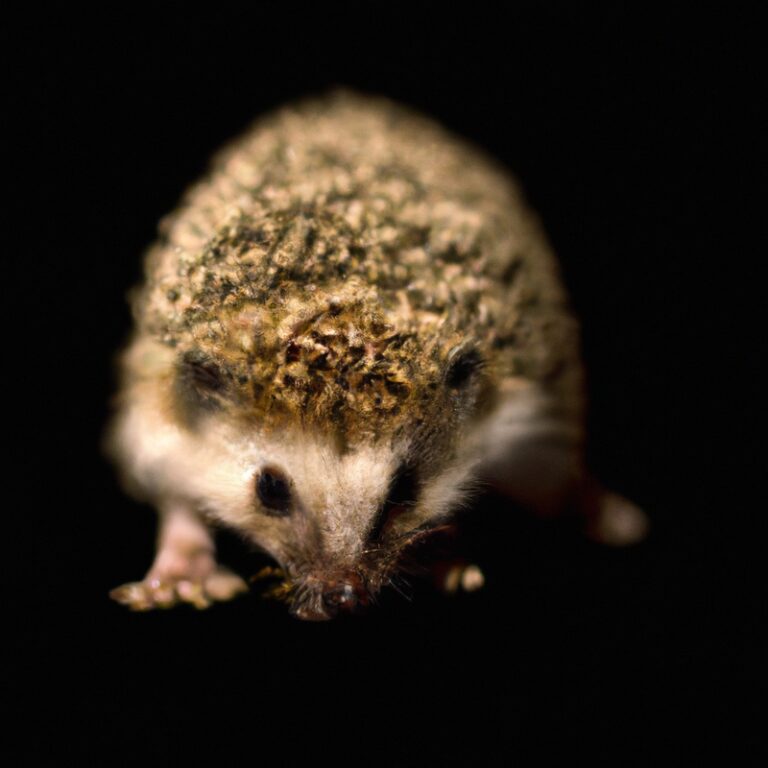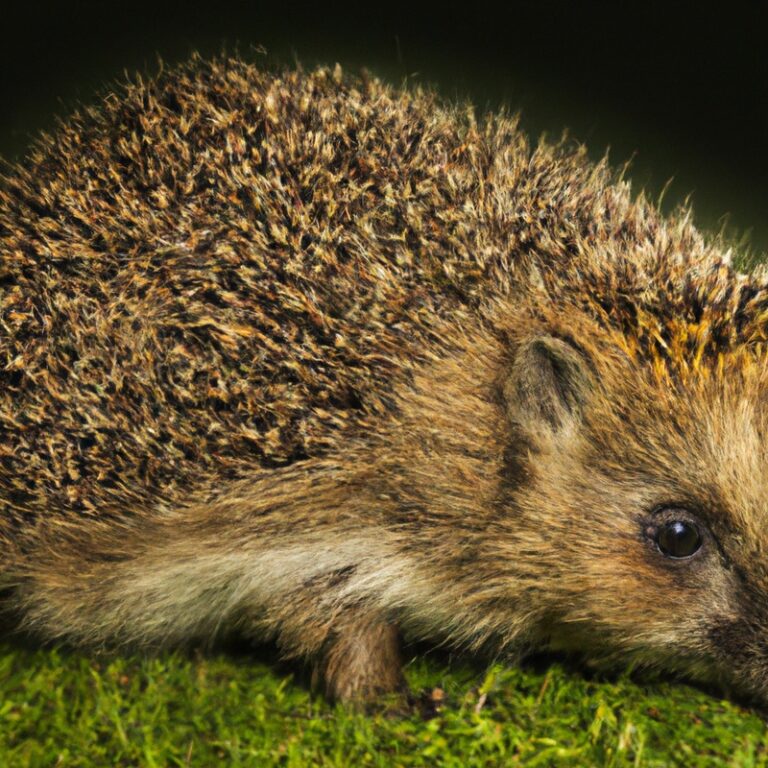How Do Hedgehogs Find Shelter In Gardens?
Key Takeaways:
- Hedgehogs use their sense of smell and hearing to locate suitable shelters in gardens.
- They may seek shelter under bushes, hedges, or piles of leaves and branches.
- Providing hedgehog houses or building small, secure shelters can help attract hedgehogs to your garden.
- Creating a hedgehog-friendly garden with access points and a supply of food and water can also encourage hedgehogs to seek shelter.
Imagine stepping into your garden on a warm summer evening, the air filled with the scent of flowers and the gentle hum of insects.
As you look around, you may not realize that hidden amidst the foliage and scattered debris are nature’s small spiky guardians – hedgehogs.
These adorable creatures, known for their prickly exteriors and endearing snuffles, rely on finding safe and cozy shelters within our gardens.
But how do they do it?
In this article, we’ll explore the natural and artificial shelter options that hedgehogs seek out, as well as tips on how you can create a hedgehog-friendly haven right in your own backyard.
| Methods | Description |
|---|---|
| Sleeping in holes and crevices | Hedgehogs find natural shelters such as holes in trees, woodpiles, or rock cracks. |
| Making nests with leaves | Hedgehogs gather leaves and create nests in dense vegetation or under bushes. |
| Using man-made shelters | Hedgehogs use purpose-built hedgehog houses, log piles, or stacks of bricks as shelters. |
| Hibernating in burrows | Hedgehogs dig burrows or use existing ones for hibernation during winter. |
| Seeking natural cover | Hedgehogs hide under dense foliage, shrubs, or any other natural cover available. |
Natural Hedgehog Shelters
Hedgehogs naturally find shelter in various hiding places in gardens, such as dense shrubs, piles of leaves or twigs, and overgrown areas. It is important to preserve these natural habitats for their survival.
Natural hiding places in gardens
Hedgehogs have a knack for finding natural hiding places in gardens. They seek out dense vegetation like shrubs, bushes, and hedges, which provide ample cover and protection.
Piles of leaves, logs, and garden debris can also serve as cozy shelters.
Additionally, they may use compost heaps and overgrown areas as hiding spots. To create a hedgehog-friendly garden, ensure there are plenty of these natural hiding places available.
Avoid using harmful chemicals and make sure there are clear access points for hedgehogs to enter and exit the garden safely.
Dense shrubs and bushes
Dense shrubs and bushes serve as excellent natural shelters for hedgehogs. They offer protection from predators and provide a cozy hiding place during the day.
Hedgehogs are known to nestle and create burrows within the dense foliage of these plants.
By including dense shrubs and bushes in your garden, you can create a safe and inviting habitat for these adorable creatures. Make sure to plant a variety of native shrubs and bushes to attract a diverse range of wildlife.
Piles of leaves or twigs
Piles of leaves or twigs create perfect shelters for hedgehogs in gardens. They can burrow into the piles to create a cozy nest that provides protection from predators and harsh weather.
Hedgehogs are also attracted to these piles because they provide a good source of food, such as insects and worms.
To create a hedgehog-friendly environment, consider leaving piles of leaves or twigs in a quiet corner of your garden. This will not only offer a safe refuge for hedgehogs but also contribute to their overall wellbeing.

Overgrown areas and wild patches
Overgrown areas and wild patches in gardens provide ideal shelter for hedgehogs. These areas offer protection from predators and a safe space for nesting and hibernating.
The dense vegetation and leaf litter create a warm, hidden environment for them.
By maintaining these wild patches in our gardens, we can create a habitat that supports hedgehog populations. Avoiding excessive pruning or clearing of vegetation can help hedgehogs find the shelter they need.

Importance of preserving natural habitats
Preserving natural habitats is essential for the survival of various species, including hedgehogs.
These habitats provide the necessary food, water, and shelter for hedgehogs to thrive.
By protecting natural habitats, we ensure the availability of resources for hedgehogs and maintain a balanced ecosystem.
Additionally, preserving natural habitats also helps to conserve biodiversity and protect the overall health of our environment.
Every effort counts in safeguarding these habitats and securing a future for hedgehogs and other wildlife.
Artificial Hedgehog Shelters
Artificial hedgehog shelters provide safe and cozy homes for hedgehogs in gardens.
Purpose-built hedgehog houses
Purpose-built hedgehog houses are specially designed shelters that provide a safe and cozy habitat for hedgehogs in gardens.
These houses offer protection from predators, extreme weather conditions, and disturbances.
They typically feature an entrance tunnel to keep out larger animals and provide a secluded space for hedgehogs to rest, hibernate, or raise their young.
These purpose-built shelters are easy to install and are an effective way to support hedgehog populations in urban areas.
Remember to place them in quiet and undisturbed areas of your garden for the best results.
Types of hedgehog houses
There are various types of hedgehog houses that you can provide in your garden to offer shelter to these adorable creatures. Here are a few options:
- Wooden hedgehog houses: These houses are made of wood and offer a cozy and safe space for hedgehogs. They often have a small entrance and an insulated interior to keep the hedgehogs warm.
- Igloo hedgehog houses: These houses are shaped like igloos and are made of sturdy, weather-resistant materials. They provide protection against the elements and predators.
- DIY hedgehog houses: If you enjoy getting creative, you can build your own hedgehog house using materials like wood, old crates, or even a plastic storage box. There are plenty of guides available online to help you with this project.
Remember, when choosing a hedgehog house, make sure it’s well-ventilated, insulated, and in a quiet area of your garden. And don’t forget to provide some dry leaves or bedding inside for added comfort.
Key features for a hedgehog-friendly house
A hedgehog-friendly house should have the following key features:
- Provide ample space for hedgehogs to explore and forage.
- Include a secluded area for nesting and hibernating, such as piles of leaves or a hedgehog house.
- Avoid the use of chemicals or pesticides in your garden to prevent harm to hedgehogs.
- Install low fences or gaps to allow hedgehogs to freely roam between gardens.
- Ensure a constant supply of fresh water and food, such as cat food or specially formulated hedgehog food.
- Create safe access points, like ramps or small steps, to help hedgehogs enter and exit your garden easily.
By considering these features, you can make your garden a welcoming and safe haven for hedgehogs.
Size and insulation
Size and insulation are key factors for hedgehogs when finding shelter in gardens.
Hedgehogs require a shelter that is spacious enough for them to move around comfortably and also provides insulation to keep them warm during colder months.
They seek out areas with dense vegetation, such as bushes or shrubs, which can provide cover and insulation from the elements.
Additionally, some people create artificial hedgehog shelters using waterproof materials like wood or plastic, with an insulated base to provide a cozy and secure hiding place.
Safe entrance and exit
Safe entrance and exit for hedgehogs is important to ensure their well-being in gardens.
Here are a few tips to create a safe environment for these adorable creatures:
- Leave gaps in fences or install hedgehog-sized tunnels to allow them to enter and exit easily.
- Avoid using netting or mesh on the ground, as hedgehogs can get tangled in it.
- Keep garden gates closed to prevent hedgehogs from wandering onto busy streets.
- Remove any hazards such as deep holes, sharp objects, or chemicals that may harm them.
- Create a welcoming habitat with bushes, shrubs, and log piles where hedgehogs can find shelter and food.
By considering these measures, you can provide hedgehogs with a safe entrance and exit, helping them to thrive in your garden.
Protection from predators
Hedgehogs have various strategies to protect themselves from predators.
One way they do this is by rolling up into a tight ball, with their spines acting as a protective barrier.
Hedgehogs also have sharp spines that deter predators from attacking.
They can also make hissing or clicking sounds to scare away potential threats.
Additionally, hedgehogs are excellent at hiding in dense vegetation and under bushes, providing them with further camouflage and making it harder for predators to spot them.
DIY hedgehog shelters
DIY hedgehog shelters are an easy and effective way to provide a safe space for hedgehogs in your garden.
Here’s how you can create one:
- Find a suitable container: Use a plastic storage box or a wooden crate with an entrance hole for the hedgehog to enter.
- Create ventilation: Drill small holes on the sides of the container to ensure proper airflow.
- Add insulation: Line the bottom of the shelter with dry leaves, straw, or shredded newspaper for insulation and warmth.
- Make it cozy: Place a layer of dry, natural bedding material like hay or dry grass for the hedgehog to nest in.
- Position the shelter: Place the shelter in a quiet, sheltered area of your garden, away from direct sunlight and potential predators.
- Provide an entrance and exit: Cut a small entrance hole, about 13cm (5 inches in diameter, on one side of the container. Make sure to elevate the entrance slightly from the ground to prevent flooding.
Remember, it’s important to regularly check and clean the shelter to keep it hygienic for the hedgehogs.
DIY hedgehog shelters are a fantastic way to encourage these adorable creatures to seek refuge in your garden.
Using recycled materials
Using recycled materials for hedgehog shelters is a great way to help the environment and provide a safe haven for these adorable creatures. You can use old crates, logs, or even repurposed plastic containers to create cozy spaces.
To make it even better, line the shelter with leaves and grass to add extra insulation.
Just remember to check for any sharp edges and secure the shelter in a quiet and undisturbed corner of your garden. It’s a win-win for hedgehogs and the planet!
Providing Food and Water for Hedgehogs
To meet the dietary needs of hedgehogs in your garden, provide suitable food options like wet or dry cat food, mealworms, and small insects. Additionally, make sure to offer fresh water in water bowls or shallow dishes, regularly changing and cleaning them.
Importance of feeding hedgehogs in gardens
Feeding hedgehogs in gardens is important because it helps them find the necessary nutrition they need to survive and thrive.
It also encourages them to visit your garden regularly, allowing you to observe these fascinating creatures up close.
By providing food, such as wet cat food or specialized hedgehog food, you can contribute to their well-being and contribute to their conservation efforts.
Remember to always provide fresh water alongside the food to keep them hydrated.
Suitable hedgehog food options
Hedgehogs have specific dietary needs to stay healthy.
Some suitable food options for hedgehogs include:
- Wet cat food: Look for varieties that are high in meat content and low in grains and additives.
- Dry cat food: Opt for formulas with a high percentage of animal protein.
- Insect-based food: Hedgehogs love insects like mealworms and crickets. You can find specialized hedgehog food that includes these.
- Plain cooked chicken: A small amount of cooked, boneless, and skinless chicken can be a tasty treat for hedgehogs.
- Hedgehog-specific food: There are commercially available hedgehog food options that are formulated to meet their nutritional needs.
It’s important to note that hedgehogs should never be fed milk, bread, or any sugary or salty foods as these can be harmful to their health.
Providing a balanced and varied diet is key to keeping hedgehogs healthy and well-fed in your garden.
Wet or dry cat food
Choosing between wet or dry cat food for hedgehogs ultimately depends on personal preference and the specific needs of the hedgehog. Wet cat food can provide hydration and may be easier for older or toothless hedgehogs to eat.
However, it can spoil quickly and may attract other unwanted animals.
Dry cat food is convenient, has a longer shelf life, and can help maintain dental health. Whatever option you choose, make sure it is a high-quality brand without artificial additives.
Always provide fresh water alongside the food.
Mealworms and small insects
Mealworms and small insects are important food sources for hedgehogs.
Hedgehogs are insectivores, which means their diet mainly consists of insects.
Mealworms and small insects provide the necessary protein and nutrients that hedgehogs need to stay healthy.
These small creatures are easily found in gardens, making them an accessible food option for hedgehogs.
By offering mealworms and keeping your garden insect-friendly, you can help support hedgehogs’ natural diet and contribute to their well-being.
Avoidance of harmful foods
To keep hedgehogs safe and healthy, it’s important to avoid feeding them harmful foods.
Here are a few things to steer clear of:
- Junk food: Avoid feeding hedgehogs any processed or sugary foods like chocolate, sweets, or crisps. These can be harmful to their digestive system.
- Milk: Contrary to popular belief, hedgehogs are lactose intolerant. Milk can cause stomach upset and diarrhea, so it’s best to avoid giving them any dairy products.
- Bread and grains: Hedgehogs have difficulty digesting grains, so it’s best to avoid feeding them bread or any other grain-based foods.
- Raw meat: Although hedgehogs are insectivores, feeding them raw meat can put them at risk of bacterial infections. Stick to commercial hedgehog food or insects as their primary diet.
Remember, a hedgehog’s natural diet consists of insects, so providing them with a specialized hedgehog food or a mixture of insects is a safe and nutritious option.
Providing fresh water for hedgehogs
Hedgehogs need access to fresh water in your garden.
You can provide them with a shallow dish of water, making sure it is easily accessible and not too deep.
Remember to refill the water regularly to keep it clean and fresh.
Adding a small rock or pebbles to the water dish can also help hedgehogs climb out if they accidentally fall in.
Water bowls or shallow dishes
Water bowls or shallow dishes are essential for providing hedgehogs with a water source in your garden. Make sure to place the bowls or dishes in a quiet and accessible part of your garden.
Hedgehogs have poor vision, so dark-colored bowls can help them locate the water easily.
Ensure that the dishes are shallow to prevent hedgehogs from falling in and getting trapped. Clean and refill the water regularly to keep it fresh and bacteria-free.
Regular water change and cleaning
Regular water change and cleaning are essential for maintaining the health and well-being of hedgehogs. By regularly changing the water in their bowls, you can ensure that they have access to clean and fresh water at all times.
Additionally, regularly cleaning their water bowls helps prevent the growth of bacteria and algae, which can be harmful to their health.
To do this, simply empty and clean the water bowls with mild soap and water, and rinse thoroughly before refilling with fresh water. Remember to check the water bowls daily and clean them as needed.
Creating a Hedgehog-Friendly Environment
To create a hedgehog-friendly environment, consider the importance of a suitable garden design and the avoidance of harmful pesticides and chemicals.
Importance of a hedgehog-friendly garden
Creating a hedgehog-friendly garden is important because it provides a safe and suitable habitat for these adorable creatures. By offering hedgehogs shelter, food, and water, you can help support their population and contribute to the local ecosystem.
A hedgehog-friendly garden also helps reduce the use of harmful chemicals and provides a natural environment for other wildlife to thrive.
Designing your garden with hedgehogs in mind can make a positive impact on their survival and biodiversity.
Avoidance of harmful pesticides and chemicals
To create a hedgehog-friendly environment in your garden, it’s important to avoid using harmful pesticides and chemicals. These substances can be toxic to hedgehogs and other wildlife, causing harm to their health and habitat.
Instead, opt for natural and organic methods to manage pests and maintain your garden.
This may include using companion planting, physical barriers, or natural pest control alternatives like neem oil or vinegar sprays. By avoiding harmful pesticides and chemicals, you are promoting a safe and welcoming space for hedgehogs to thrive.
Hedgehog-friendly fencing and gates
Hedgehog-friendly fencing and gates are important for creating a safe environment for these spiky creatures. Here are some tips:
- Opt for hedgehog-friendly fencing that has gaps or holes no larger than 13cm.
- Avoid solid barriers that hedgehogs cannot pass through.
- Install self-closing gates to prevent hedgehogs from wandering onto roads.
- Consider creating hedgehog-sized openings in your fencing to allow them to freely move between gardens.
- Regularly check your fencing and gates for any gaps or damage that could potentially trap or harm hedgehogs.
Avoidance of hazards like ponds or steep drops
To avoid hazards like ponds or steep drops in your garden, make sure to create barriers or fences around these areas to prevent hedgehogs from accidentally falling in. Additionally, cover or secure any open or deep holes, as hedgehogs can easily get trapped.
Keep your garden free of clutter and debris, as these can create hazards for hedgehogs to navigate around.
Also, regularly check your garden for any potential dangers and address them promptly. By taking these precautions, you can ensure a safe environment for hedgehogs to thrive in your garden.
Minimizing excessive lighting at night
Excessive lighting at night can have negative effects on hedgehogs. To minimize this, make sure outdoor lights are downward-facing or shielded to limit the amount of light that spreads.
Consider using motion-activated or timer-controlled lights to reduce unnecessary illumination.
Furthermore, avoid leaving lights on throughout the night and switch off any unnecessary lighting before you go to bed. These simple actions can help create a more suitable environment for hedgehogs to thrive.
Frequently Asked Questions (FAQs)
How do hedgehogs find shelter naturally?
Hedgehogs find shelter naturally in various ways. They often seek out dense vegetation like bushes or hedges where they can hide from predators and inclement weather.
Hedgehogs also create their own shelters by burrowing under piles of leaves, fallen branches, or other debris in the garden.
Some may even find shelter in compost heaps or piles of logs. Providing these natural hiding spots in your garden can help attract and support hedgehogs.
Can hedgehogs hibernate in garden shelters?
Yes, hedgehogs can hibernate in garden shelters.
Garden shelters provide a safe and protected environment for hedgehogs to hibernate during the winter months.
These shelters can include piles of leaves, brushwood, or specially designed hedgehog houses.
They offer insulation and protection from the cold and predators.
Providing a garden shelter for hedgehogs is a great way to support their survival and well-being during hibernation.
How often should a hedgehog shelter be cleaned?
To keep a hedgehog shelter clean and hygienic, it’s recommended to clean it at least once every week.
Remove any soiled bedding and replace it with fresh bedding to maintain a clean and comfortable environment for the hedgehog.
Regular cleaning helps prevent the buildup of waste and bacteria, promoting the hedgehog’s health and well-being.
Additionally, ensure that the shelter is dry and free from any potential hazards or debris that could harm the hedgehog.
Can other animals use hedgehog shelters?
Other animals can indeed use hedgehog shelters, especially if they are vacant or unoccupied.
Small mammals such as mice or shrews may take advantage of these shelters during periods of unfavorable weather or when they are looking for a safe place to rest.
Additionally, birds might use hedgehog shelters as temporary resting spots or even as nesting areas.
It’s important to keep this in mind when creating hedgehog shelters, as they can provide valuable refuge for various creatures in need.
What should I do if I find an injured hedgehog in my garden?
If you find an injured hedgehog in your garden, the best thing to do is to contact a local wildlife rescue or veterinary clinic. They are equipped to provide the necessary care and treatment for the hedgehog.
In the meantime, you can gently place the hedgehog in a box or crate lined with a towel or newspaper, and keep it in a quiet and warm place.
Avoid giving it food or water without professional advice, as it may have specific dietary requirements. It’s important to let the experts handle the situation to ensure the hedgehog receives proper care and has the best chance of recovery.
Final Verdict
Hedgehogs find shelter in gardens through a combination of natural and artificial options. Natural hiding places such as dense shrubs, leaf piles, and overgrown areas provide them with protection.
However, it’s important to preserve these habitats.
Artificial hedgehog shelters, like purpose-built houses or DIY options, offer a safe and secure space for hedgehogs to rest and hibernate. Providing food and water, creating a hedgehog-friendly environment, and avoiding harmful pesticides are essential for their survival.
By taking these steps, we can create a welcoming sanctuary for hedgehogs in our gardens and help conserve this beloved species.







